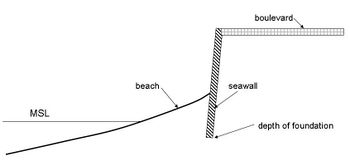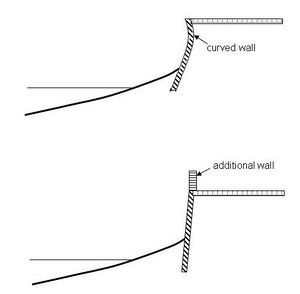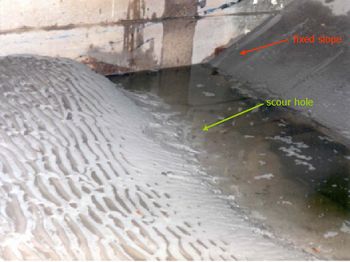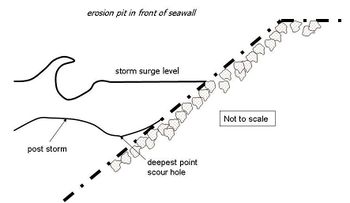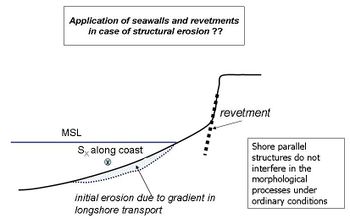Seawalls and revetments
This article introduces the hard coastal protection structures seawalls and revetments. The article explains how and why the application of a seawall or revetment can be used to solve coastal engineering problems in practice. It also discusses why they should not be used as a solution to problems related to structural erosion.
Contents
Introduction
Seawalls or revetments are shore-parallel structures at the transition between the (sandy) beach and the (higher) mainland or dune. The height of a seawall often covers the total height difference between the beach and the surface level of the mainland. In many cases, there is a horizontal stone-covered part adjacent to the top of a seawall (e.g. boulevard, road or parking lot). At the time of construction, a seawall is often located on the upper dry beach. In the current article, a seawall is considered to be a nearly vertical structure (often a bulkhead). The seaward side of the seawall has a relatively smooth surface.
A revetment, like a seawall, is a structure parallel to the shore. The main difference is that it is more inclined than a seawall. The slope of a revetment is often 1:2-1:4 and the surface of a revetment can be smooth or rough (rubble). The height of a revetment does not necessarily cover the total height difference between beach and mainland.
Slightly different definitions are given in the definition pages of seawall and revetment. For more information on different types, characteristics and application of revetments, see also the article Revetments. For some general information on seawalls, see also Seawall.
Solving coastal engineering problems
Beach-mainland transition
Especially in sandy coastal areas with many human (recreational) activities, a clear and fixed distinction between beach and mainland can be desirable. A seawall will serve that purpose. On the sea side of the seawall a more or less normal beach is assumed to be present; on the landward side a road or a boulevard is present. Staircases facilitate the access to the beach.
We assume the coast to be stable; the beach in front of the seawall does not erode, or in case of a structurally eroding coast, a (time-averaged) stable situation has been achieved with, for example, regular artificial beach nourishments. So a normal beach is assumed to be present in front of the seawall that can be used for recreational purposes. See Figure 1.
While even a moderate storm (surge) will attack and erode the mainland in a situation without a seawall, this is prevented in the situation with a seawall. Scour in front of the seawall during a storm surge must be taken into account in the design. A part of the 'denied' erosion volume from the mainland is now eroded from the beach just in front of the seawall. The scour hole may undermine the seawall. With numerical models an estimate of the expected scour depth can be made. [1]
The design conditions for the sea defence must be chosen carefully. The more severe the design conditions, the heavier the sea defence must be built and especially the 'safe' foundation depth will increase accordingly (see Stability of rubble mound breakwaters and shore revetments). Building a seawall which will be safe under 'all' conditions may be an unrealistic option. The selected design conditions determine the rate of protection provided for infrastructure on the mainland.
The crest height of a seawall largely determines (together with the boundary conditions at sea) the rate of overtopping. Water reaches the mainland by wave run-up, breaking waves and splash water transported by landward directed wind, see the article Wave overtopping. With an additional wall and/or a slightly curved front, rates of overtopping may be reduced; see Figure 2.
Protection of coastal assets
Infrastructure and buildings situated close to the edge of mainland or dunes have a chance (probability) of being destroyed during a severe storm surge.
The risk (risk = chance x consequence) can be deemed too high in a given situation. An increased risk may arise, for example, when urban infrastructure on the seafront is upgraded. An acceptable 'risk' level can be recovered by reducing the 'chance' (destruction probability). With a robust seawall or revetment the desired goal can be achieved. Aspects like proper design conditions and scour holes are in this case similar to the discussion in the previous case.
Let us assume that a very heavy storm surge causes a mainland erosion of, for example, 40 m in an unprotected part of the coast. With a seawall that can withstand these conditions, the mainland erosion would be zero. A scour hole will be formed in front of the seawall (Figure 3). However, no further problems will arise if the entire seawall retains its integrity. On the other hand, if the seawall partially collapses and a local breach is formed in the seawall during the heavy storm surge, a dangerous situation will arise. A large volume of sediment from the mainland can disappear through the gap and will flow along the sections of the seawall which are still in good condition, filling the scour holes in both longshore directions adjacent to the gap. It is expected that the ultimate erosion of the mainland behind the gap will be larger in this case than the 40 m mentioned for the unprotected case.
Similar phenomena occur at the transitions between the seawall and the adjacent, unprotected parts of the coast. Adjacent to an abrupt end of a seawall, strong erosion can occur during a severe storm surge.
Prevent dune failure
Now consider the situation of a dune row that is too weak (too slender) to meet the safety requirements for the protection of low-lying hinterland. Under design conditions, a dune breach can be expected; the land behind the slender dune row will then be flooded. A seawall or revetment could be chosen as a solution, provided that the seawall or revetment retains its integrity during the design conditions. A risky alternative design would be to 'allow' the structure to collapse at a later stage of the storm surge. The time remaining until the end of the storm surge (with lower water levels) is then considered too short for a dune breach to occur.
Scour at the toe of the seawall/revetment
The development of a scour hole in front of a seawall was investigated in the Delta Flume of WL|Delft Hydraulics, see Figure 3. For rather smooth revetments it was shown that the depth of the scour hole depends on the slope characteristics. With a slope of 1:3.6 a deeper scour hole was found than with a slope of 1:1.8 (other test conditions the same). The deepest point of a scour hole is not always found at the intersection point between revetment and cross-shore profile (see Figure 4 for a sketch). It is probable that the depth of a scour hole is less for a rough slope than for a smooth slope.
Different pieces of evidence on the development of scour holes in front of a seawall or revetment are provided by field observations, laboratory experiments and numerical modeling:
- Maximum wave impact is observed when the seawall is positioned on the beach at the still water line[2]. Consequently, the strongest scour at the seawall toe is observed for this location. Locating the wall away from this position leads to a decrease in wave impact and consequently a decrease in the scour depth at seawall toe. [3] However, tides and storm surges move the still water line.
- Seawalls located around or above the storm surge high water line only have a minor influence on the beach profile[4].
- The scour depth [math]S[/math] decreases with an increasing water depth at the seawall toe[5].
- The scour depth increases with incident wave height [math]H_0[/math]. Reflection of high waves on the seawall leads to the development of a standing wave pattern, which creates a second scour hole seawards[2].
- The seawall scour increases with increasing seabed slope steepness. For a mild slope, most of the wave energy is dissipated before hitting the seawall. This results in a reduced wave impact and consequently a smaller scour at the seawall toe. However, for steep seabed slopes, the incident waves break on the wall. A stronger wave impact and a greater scour depth are therefore observed at the seawall toe[2].
- The scour at the seawall toe increases with increasing wave steepness. This effect is more significant if the wave steepness exceeds 0.032 [6].
- The seawall scour depth depends on the surf similarity parameter [math]\xi=m / \sqrt{H_0/L}[/math], where [math]m[/math] is the seabed slope in front of the seawall and [math]L[/math] the deep water wavelength. The ratio [math]S /H_0[/math] increases almost linearly with [math]\xi[/math] from 0.35 and 0.8 as [math]\xi[/math] increases from 0.5 to 1.3, but does not increase further for larger values of [math]\xi[/math] [2].
Accelerated beach erosion

Construction of a seawall or revetment on the upper beach of an eroding coast sets a limit to shoreline retreat. However, it can accelerate beach erosion and lead to beach loss (see Figure 5). Field evidence is controversial in this regard, however. The following processes can play a role in beach erosion:[7]
- A seawall cuts off the beach from inshore sand sources (e.g. dune, bluff).
- When storm waves erode the upper beach, the lack of inshore sand supply accelerates and amplifies beach lowering and retards the development of a nearshore bar.
- Profile lowering and lowering of the nearshore sand bar expose the beach to strong wave attack.
- If the scour trench is filled with sand from updrift longshore transport, the downdrift beach will erode due to insufficient sand supply[8].
- Shoreface steepening concentrates the wave attack on a smaller part of the profile and hampers beach recovery a after storm.
- The width of the dry part of the lowered beach after storm erosion is not sufficient to allow the rebuilding of the upper beach by aeolian transport.
Longshore sediment transport
Structural erosion caused by a gradient in alongshore sediment transport (spatial increase in the rate of sediment transport) means that volumes of sediment are lost from the active cross-shore profile (for a more detailed article on this, see Dealing with coastal erosion). This loss process mainly occurs under average conditions; the contribution of storm conditions to the total sand loss is often relatively small. The sand losses mainly occur in the subaqueous part of a cross-shore profile where alongshore sediment transport takes place. The 'dry' parts of a cross-shore profile are not involved in alongshore sediment transport; this gives the impression that the 'dry' parts are not an integral part of the cross-shore profile under normal conditions.
During high tides and/or moderate storms (storm surges) all parts of a cross-shore profile are subject to sediment transport processes. By offshore directed cross-shore sediment transports, sediments are transported from the higher parts of the profile (the 'dry' beach, and even the mainland under severe conditions) to deeper water, where they are removed by downdrift sediment transport (see Figure 6). This sequence of processes causes a permanent loss of material out of the upper parts of a cross-shore profile.
By 'protecting' the mainland in this case with a seawall, one indeed prevents sediments from the mainland from being transported in a seaward direction. However, the losses continue; the 'dry' beach disappears and it becomes increasingly deeper in front of the sea wall. After the construction of the seawall, a more or less normal dry beach was initially present. The beach did 'protect' the seawall to some extent; only moderate storms could reach the sea wall. After the beach has disappeared, waves more often directly attack the seawall. Continuous reinforcements of the seawall are necessary to prevent damage, undermining and collapse. The foregoing shows that seawalls and revetments do not solve erosion problems caused by gradients in longshore sediment transport. In coastal engineering practice, this principally 'wrong' solution is still often applied. Many bad examples can be found all over the world.
A somewhat confusing element is the time-scale of the developments as have been discussed so far. Local people (their houses are at stake) have noticed that in the past every storm surge has taken some square metres of their gardens. The edge of the mainland is coming closer and closer to their houses. Not seldom the responsible coastal zone manager is 'forced' by the local people 'to do something'. Locally building a seawall or revetment in front of the properties which are situated closest to the sea, indeed seems to resolve the problem. During the next storm surge, the just 'protected' parts of the coast show no further erosion; in the unprotected parts the erosion of the mainland continues. Local people believe that this solution 'works' (own experience). The coastal zone manager is forced to build seawalls along the other parts of the coast as well. However, when time elapses, it will become clear that a wrong solution has been chosen. Only with huge costs the situation can be redressed.
Related articles
- Structural erosion
- Definition of seawall and revetment
- Stability of rubble mound breakwaters and shore revetments
- Hard coastal protection structures
- Bulkhead
- Dealing with coastal erosion
- Erosion hotspots
References
- ↑ Steetzel, H.J. 1993. Cross-shore Transport during Storm Surges. Ph.D. Thesis Delft University of Technology.
- ↑ 2.0 2.1 2.2 2.3 Ahmad, N., Bihs, H., Myrhaug, D., Kamath, A. and Arntsen, O.A. 2019. Numerical modeling of breaking wave induced seawall scour. Coast. Eng. 150: 108–120
- ↑ 3.0 3.1 Ruggiero, P. 2010. Impacts of shoreline armoring on sediment dynamics, in Shipman, H., Dethier, M.N., Gelfenbaum, G., Fresh, K.L. and Dinicola, R.S., eds., 2010, Puget Sound Shorelines and the Impacts of Armoring—Proceedings of a State of the Science Workshop, May 2009: U.S. Geological Survey Scientific Investigations Report 2010-5254, p. 179-186
- ↑ Kraus, N.C. and McDougal, W.G. 1996. The effects of seawalls on the beach: Part I, an updated literature review. J. Coast. Res. 12: 691–701
- ↑ Tsai, C.P., Chen, H.B. and You, S.S. 2009. Toe scour of seawall on a steep seabed by breaking waves. J. Waterw. Port, Coast. Ocean Eng. 135: 61–68
- ↑ El-Bisy, M.S. 2007. Bed changes at toe of inclined seawalls. Ocean Engineering 34 (3-4): 510–517
- ↑ Pilkey, O. H. and Wright, H. L. 1988. Seawalls versus beaches. Journal of Coastal Research 4: 41–64
- ↑ Balaji, R., Kumar, S.S. and Misra, A. 2017. Understanding the effects of seawall construction using a combination of analytical modelling and remote sensing techniques: Case study of Fansa, Gujarat, India. The International Journal of Ocean and Climate Systems 8, 175931311771218
Please note that others may also have edited the contents of this article.
|
